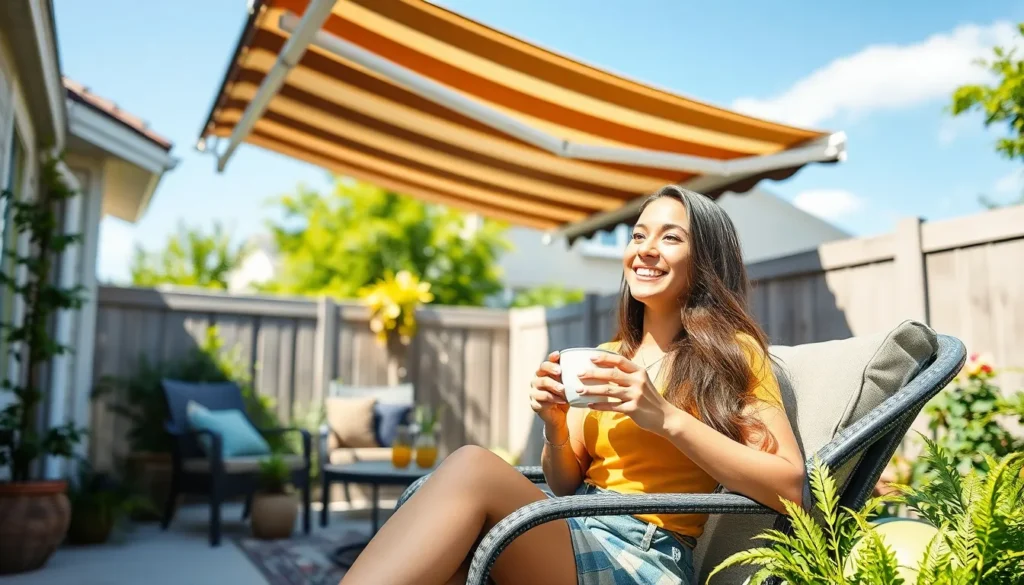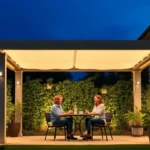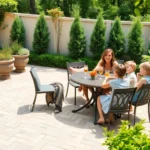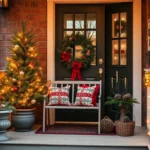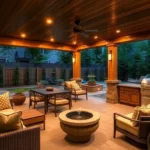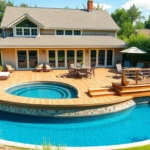Summer heat shouldn’t force you to abandon your beautiful outdoor space. We’ve all experienced that moment when the sun becomes too intense to enjoy our patios comfortably, turning what should be a relaxing retreat into an unbearable hotspot.
Creating effective shade for your patio transforms it into a year-round sanctuary where you can entertain guests, enjoy morning coffee, or simply unwind after a long day. The right shade solution doesn’t just protect you from harsh UV rays – it extends your living space and significantly increases your home’s value.
We’ll explore practical and stylish shade options that fit every budget and patio size. From quick DIY answers to permanent installations, these ideas will help you reclaim your outdoor space and create the perfect balance of comfort and style. Let’s jump into the shade answers that’ll make your patio the envy of the neighborhood.
Retractable Awnings for Flexible Patio Coverage
Retractable awnings offer the perfect balance of sun protection and flexibility for your patio space. We can extend them during hot afternoons and retract them when we want full sunlight or clear views of the sky.
Manual vs. Motorized Options
Manual retractable awnings provide an affordable entry point into flexible patio shading. We operate these systems using a hand crank mechanism that extends and retracts the awning fabric. Most manual models cost between $200 to $800 depending on size and fabric quality.
Motorized retractable awnings offer convenience at the push of a button. We can control these systems with wall switches, remote controls, or smartphone apps. Premium motorized options include wind sensors that automatically retract the awning during storms. Expect to invest $800 to $3,000 for motorized systems.
Hybrid models combine both manual and motorized operation. We get the convenience of electric operation with manual backup during power outages. These systems typically cost $500 to $1,500 more than basic manual versions.
Fabric Choices and Durability Considerations
Acrylic fabrics deliver the best combination of durability and color retention for retractable awnings. We recommend solution-dyed acrylic materials like Sunbrella that resist fading for 10+ years. These fabrics block 94-99% of UV rays while maintaining breathability.
Vinyl-coated polyester provides waterproof protection at a lower cost than acrylic options. We see these materials perform well in wet climates but they may crack after 5-7 years of sun exposure. Most vinyl options cost 30-40% less than premium acrylic fabrics.
Canvas materials offer natural aesthetics but require more maintenance than synthetic alternatives. We need to treat canvas awnings annually with water-resistant coatings. Untreated canvas typically lasts 3-5 years before showing important wear.
| Fabric Type | UV Protection | Lifespan | Water Resistance | Price Range |
|---|---|---|---|---|
| Solution-dyed Acrylic | 94-99% | 10-15 years | Water repellent | $8-15/sq ft |
| Vinyl-coated Polyester | 85-95% | 5-7 years | Waterproof | $5-10/sq ft |
| Treated Canvas | 80-90% | 3-5 years | Water resistant | $4-8/sq ft |
Installation Requirements and Costs
Wall mounting represents the most common installation method for retractable awnings. We need solid wall surfaces like brick, concrete, or wood studs to support the mounting brackets. Professional installation typically costs $300 to $600 for standard residential projects.
Ceiling mounting works well for covered patios or areas with overhead structures. We require additional support beams for ceiling installations due to different load distribution. Expect installation costs to increase by $200 to $400 for ceiling-mounted systems.
Freestanding frames eliminate the need for wall attachment but require concrete footings for stability. We recommend this option for patios without suitable mounting surfaces. Complete freestanding installations range from $800 to $1,500 including frame and concrete work.
DIY installation can reduce costs by 50-70% for handy homeowners. We need basic tools like drills, levels, and ladders plus 4-6 hours for typical installations. Most manufacturers provide detailed instructions and mounting hardware with their awning kits.
Pergola Structures for Stylish Overhead Protection
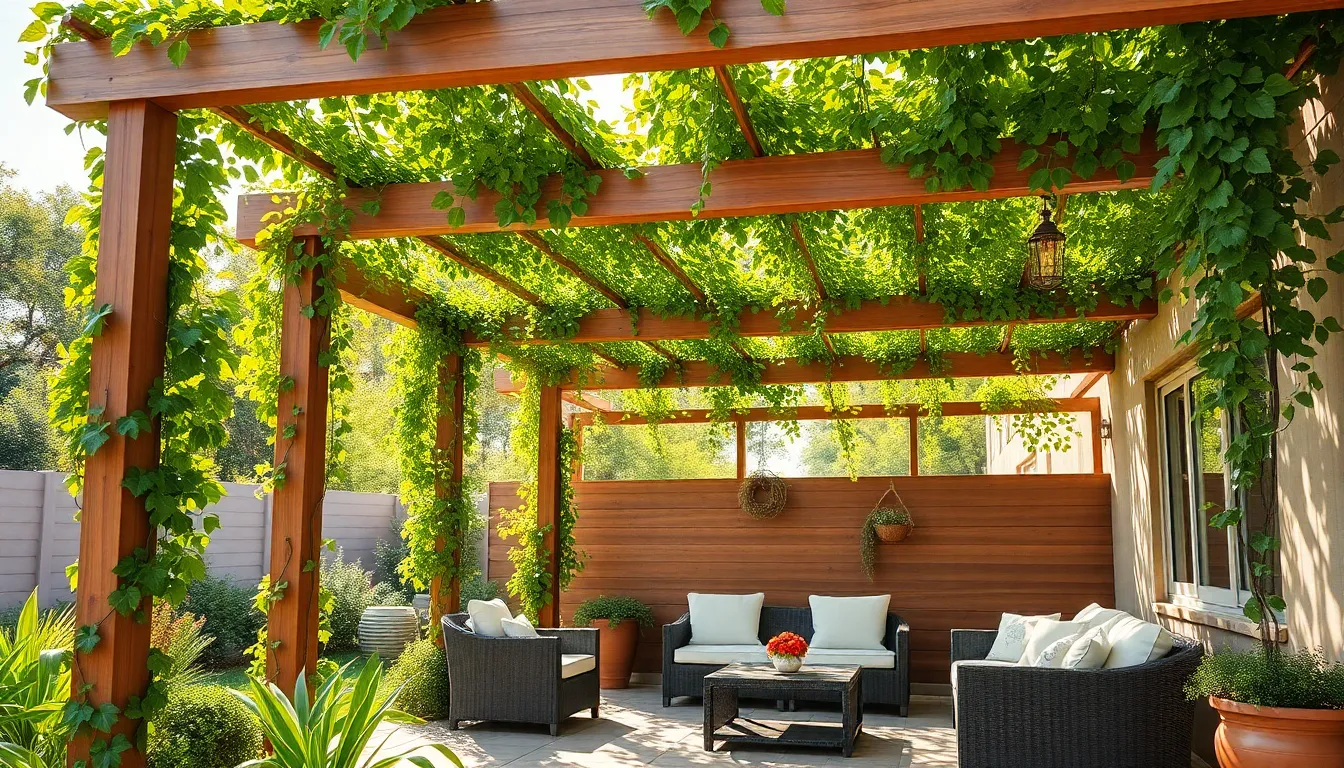
Pergolas offer versatile outdoor structures that combine aesthetic appeal with functional shade answers. We’ll explore how these overhead protections can transform your patio into a comfortable retreat while adding architectural interest to your outdoor space.
Traditional Wooden Pergola Designs
Wooden pergolas deliver timeless charm with their warm, natural appearance that complements various garden and patio styles. Classic designs feature open lattice roofs that allow filtered sunlight and promote excellent air circulation throughout your outdoor space.
Enhanced shade options for wooden pergolas include UV resistant polycarbonate panels that provide fixed roof protection from sun, rain, and snow while maintaining long lasting durability. Tensioned fabric canopies represent another popular approach, attaching directly to wooden frames to enhance shade coverage while preserving the pergola’s rustic aesthetic appeal.
Installation flexibility makes wooden pergolas adaptable to different patio layouts and sizes. Traditional cedar and pressure treated lumber options offer natural weather resistance, while composite wood alternatives provide reduced maintenance requirements without sacrificing the classic wooden appearance.
Modern Metal and Vinyl Alternatives
Metal and vinyl pergolas are gaining popularity due to their minimal maintenance requirements and sleek contemporary designs. These materials support oversized modern structures with clean architectural lines that complement today’s outdoor living trends.
Advanced shade answers for metal pergolas include motorized retractable canopies that provide adjustable sunlight control throughout the day. Outdoor curtains offer additional privacy and flexible shade options, transforming your pergola into a versatile outdoor room environment.
Innovative features like PowerGazebos combine solar panel technology with shade functionality, creating energy efficient outdoor structures. Aluminum frames resist rust and corrosion while vinyl options provide excellent weather resistance with easy cleaning maintenance schedules.
Adding Climbing Plants for Natural Coverage
Integrating climbing plants creates organic overhead shade that enhances your patio’s natural ambiance. Vines grow over pergola lattice structures, providing living coverage that naturally cools the space beneath while supporting eco friendly landscaping approaches.
Popular plant choices include grape vines, wisteria, and jasmine that offer seasonal coverage variations throughout the year. These natural canopies filter sunlight effectively while creating visually appealing overhead gardens that change with growing seasons.
Growth considerations require planning for plant maturity and seasonal maintenance schedules. Fast growing varieties like morning glory provide quick coverage, while slower growing options like climbing roses offer long term beauty with fragrant seasonal blooms that attract beneficial pollinators.
Shade Sails for Contemporary Outdoor Spaces
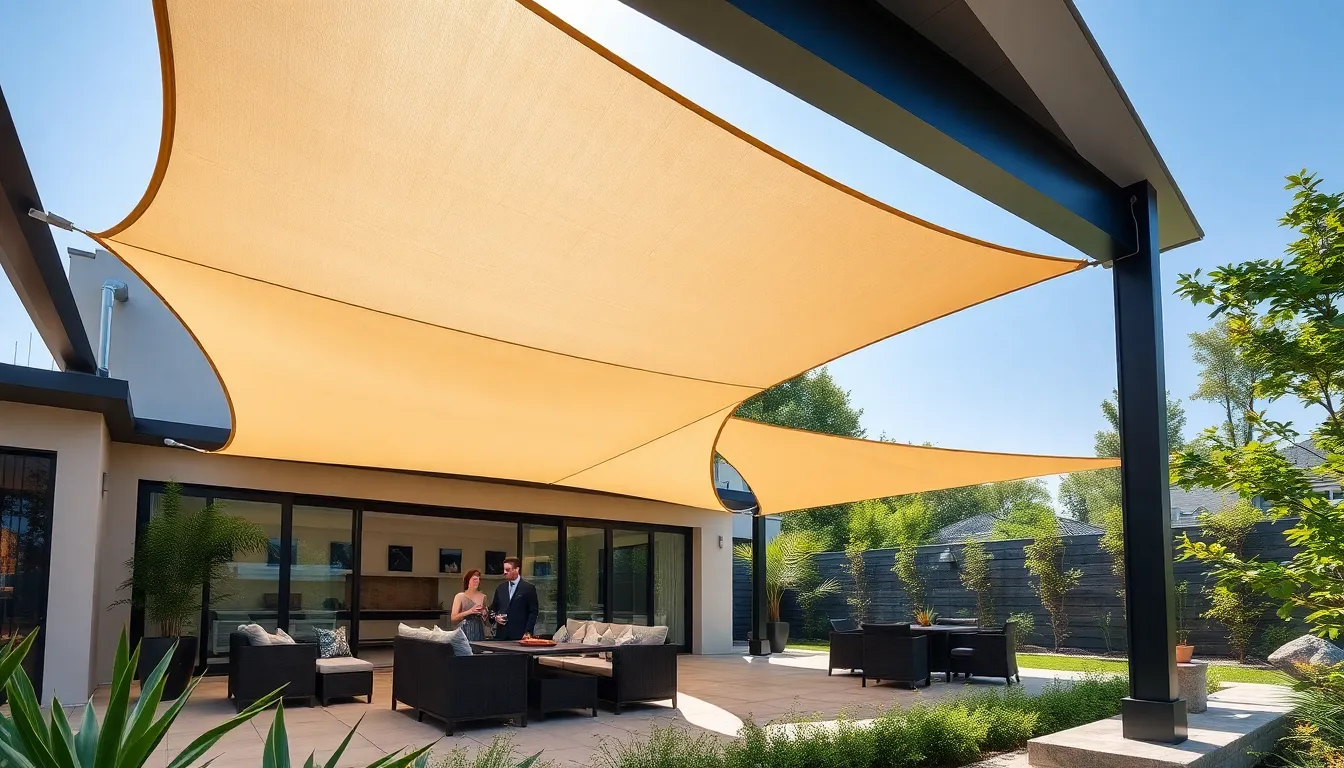
Modern shade sails bring architectural elegance to outdoor spaces while delivering exceptional sun protection. These contemporary shading answers offer unmatched versatility for patios seeking a sleek, minimalist aesthetic.
Triangle, Square, and Custom Shape Options
Triangular shade sails create ever-changing visual interest while maximizing coverage for smaller patio areas. We recommend these angular designs for modern homes wanting to add geometric appeal to their outdoor spaces.
Square configurations provide balanced coverage and work exceptionally well over dining areas or seating zones. These classic shapes offer straightforward installation with four anchor points for secure positioning.
Custom sizing allows us to adapt shade sails to unique patio dimensions and design preferences. Specialized manufacturers create customized shapes that perfectly fit irregular spaces, bay windows, or L-shaped patios where standard options won’t work effectively.
Proper Installation and Anchor Points
Strong anchor points form the foundation of successful shade sail installation. We identify suitable mounting locations like house walls, sturdy poles, or mature trees that can handle tension loads.
Essential hardware includes eye bolts, pad eyes, and turnbuckles for securing sails with proper tension. Installation requires drilling into walls with Ø12 drill bits to create secure attachment points that won’t fail under wind stress.
Tension maintenance uses D-shackles, steel wire, or winch kits to keep sails taut and easily adjustable. Proper tensioning prevents sagging and reduces fabric stress that can lead to premature wear.
Strategic placement considers sun angles and prevailing wind conditions to optimize shade coverage throughout the day. We position sails to block afternoon sun while allowing morning light to filter through adjacent areas.
UV Protection Ratings and Fabric Quality
High-performance polyethylene fabric blocks 90-95% of harmful UV rays while reducing underneath temperatures by approximately 10 degrees Fahrenheit. This substantial protection makes outdoor spaces comfortable during peak sun hours.
| Fabric Type | UV Protection | Key Benefits | Durability |
|---|---|---|---|
| Standard | 90% | Breathable, cost-effective | 5-7 years |
| Super Ring | 95% | Enhanced edges, stronger | 7-10 years |
| Waterproof | 95% | Rain protection, premium | 8-12 years |
Quality fabric options include standard, super ring, and waterproof versions that offer different benefits for exact needs. Waterproof versions provide rain protection alongside sun blocking, while super ring fabrics feature reinforced edges for extended lifespan.
Breathable construction maintains air circulation underneath while providing shade, preventing the trapped heat that solid covers can create. This ventilation keeps covered areas comfortable without feeling stuffy or enclosed.
Market Umbrellas for Portable Patio Shade
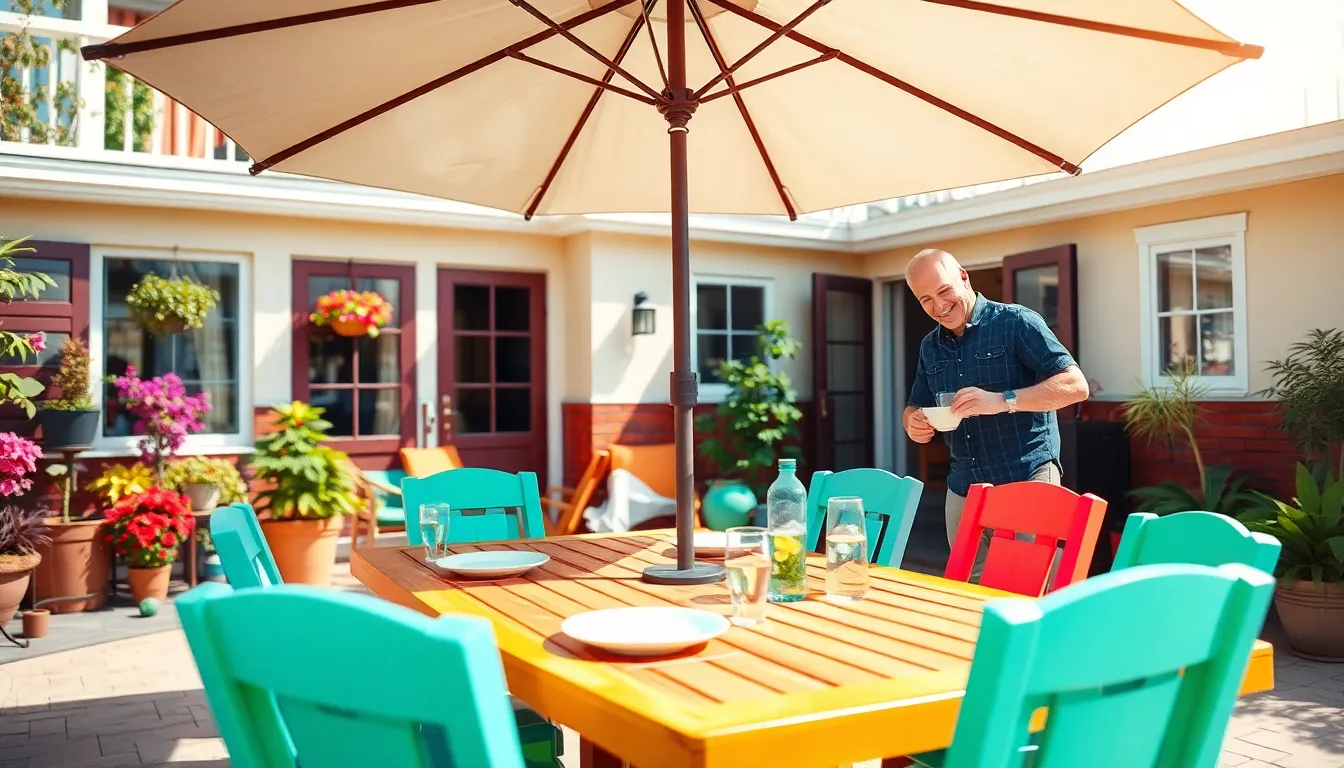
Market umbrellas offer the ultimate flexibility for patio shade, allowing us to easily move and adjust coverage throughout the day. These versatile shade answers feature a traditional center-pole design that’s become synonymous with outdoor dining and entertaining spaces.
Cantilever vs. Center Pole Designs
Center pole market umbrellas provide the classic patio aesthetic we’re all familiar with, featuring a sturdy pole that runs directly through the center of the canopy. We can integrate these umbrellas seamlessly with dining tables that have umbrella holes, creating a cohesive outdoor dining experience. The central support offers excellent stability, though it does limit movement and seating arrangements directly underneath.
Cantilever umbrellas revolutionize patio shade by mounting the support pole to one side, eliminating the central obstruction entirely. We gain complete freedom to position furniture anywhere under the canopy without working around a center pole. This offset design proves especially valuable for poolside lounging, large dining sets, or flexible seating arrangements that change throughout the day.
Size Selection for Different Patio Areas
Small patios and intimate spaces work best with umbrellas measuring 6 to 7 feet in diameter, providing adequate coverage for bistro sets or small conversation areas. We recommend these compact sizes for cozy breakfast nooks or apartment balconies where space comes at a premium.
Medium to large dining areas require umbrellas spanning 9 to 11 feet to effectively shade dining tables plus surrounding chairs. We find this size range covers most standard patio furniture arrangements while leaving room for guests to move comfortably around the perimeter.
Oversized commercial grade umbrellas measuring 11 feet or larger transform expansive patios into shaded retreats suitable for entertaining larger groups. We often see these statement pieces anchoring high traffic outdoor spaces or serving as focal points in industry design.
Wind Resistance and Stability Features
Vented canopy designs allow wind to pass through strategically placed openings, significantly reducing uplift forces that can damage or topple umbrellas. We’ve found these ventilation systems crucial for maintaining stability during unexpected weather changes.
Heavy duty base systems anchor umbrellas securely to patio surfaces using weighted stands, bolt down plates, or sand filled bases. We recommend bases weighing at least 50 pounds for standard umbrellas, with heavier options required for larger canopies or windy locations.
Reinforced frame construction using aluminum, teak, bamboo, stainless steel, or fiberglass provides the structural integrity needed to withstand seasonal weather patterns. We prioritize umbrellas with robust ribs and joints that resist bending or breaking under stress, ensuring years of reliable shade coverage.
Gazebo Installations for Complete Patio Enclosure

Gazebos represent the ultimate patio shade solution when you’re seeking complete outdoor enclosure. These structures transform your patio into a dedicated outdoor living room that functions as a true extension of your indoor space.
Permanent vs. Temporary Gazebo Options
Permanent gazebos offer the most comprehensive patio enclosure with year-round reliability and enhanced functionality. Built from sturdy materials like cedar wood or heavy-duty metal, these installations provide consistent shelter and can accommodate electrical wiring for integrated lighting and ceiling fans. Wooden designs particularly excel in durability while adding natural visual appeal to your outdoor space. Installation requires more planning and investment, but the result delivers a true outdoor room that increases your home’s value.
Temporary gazebos provide flexible shading through pop-up canopy designs that assemble and disassemble for seasonal use. These lightweight structures offer immediate shade relief without permanent installation commitments. Pop-up canopies work best for occasional entertaining or seasonal patio use, though they lack the weather resistance needed for harsh conditions. Storage becomes simple during winter months, and relocation allows you to adjust your patio layout as needed.
Soft-Top and Hard-Top Roof Materials
Soft-top roofs use fabric or canvas materials to create lightweight, customizable shade coverage. These roofing options allow diffused natural light to filter through while blocking harmful UV rays. Retractable soft tops offer the flexibility to adjust shade coverage throughout the day, while fixed installations provide consistent protection. Fabric options range from weather-resistant polyester to premium solution-dyed acrylics that resist fading and moisture damage.
Hard-top roofs deliver superior protection through wood, metal, or polycarbonate construction materials. These durable roofing systems withstand severe weather conditions including heavy rain, wind, and snow loads. Polycarbonate panels offer excellent UV protection while maintaining light transmission for bright, comfortable spaces underneath. Metal roofing provides maximum durability with minimal maintenance requirements, though installation costs increase significantly compared to soft-top alternatives.
Integrated Lighting and Electrical Features
Built-in lighting systems transform gazebo installations into functional evening entertainment spaces. LED strip lighting creates ambient illumination along rooflines, while hanging pendant lamps provide focused task lighting for dining or reading areas. Solar-powered options eliminate electrical installation requirements while reducing ongoing energy costs.
Ceiling fans improve air circulation within enclosed gazebo spaces, creating comfortable conditions even during humid summer weather. Variable speed controls allow precise comfort adjustment, while integrated lighting combines functionality with convenience. Electrical installations require proper weatherproofing and GFCI protection for outdoor safety compliance.
Power outlets enable convenient access to electrical devices for entertaining, cooking, or working in your outdoor space. Weatherproof outlet covers protect connections from moisture while maintaining accessibility. Professional electrical installation ensures code compliance and safe operation of all integrated features within your gazebo enclosure.
Living Shade Solutions Using Plants and Trees
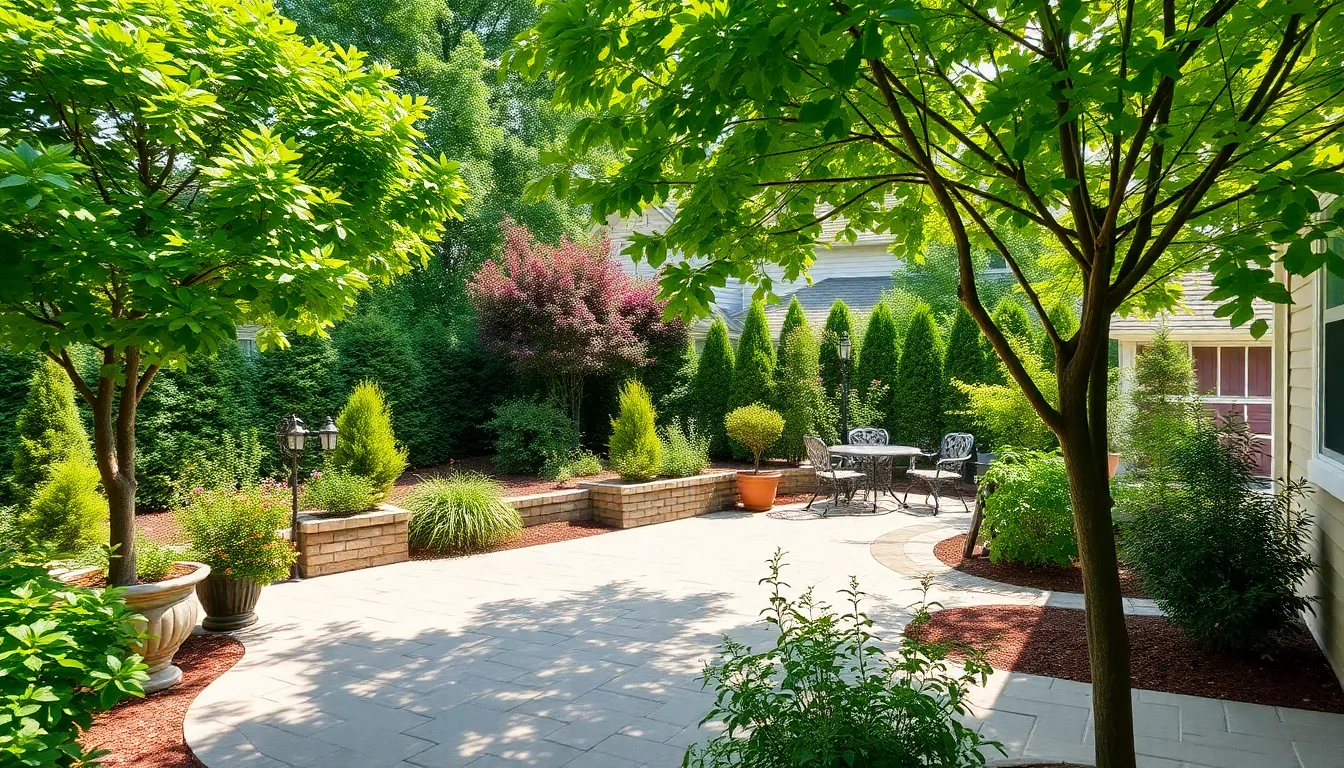
Natural shade transforms your patio into a cooler, more inviting space while adding living beauty to your outdoor environment. Plants and trees create organic cooling zones that can reduce temperatures by up to 20 degrees compared to traditional hardscaping materials.
Fast-Growing Trees for Natural Coverage
Fast-growing trees deliver immediate shade relief while establishing long-term outdoor comfort. Crape Myrtle stands out as our top choice for vibrant seasonal color and manageable size, perfect for medium patios where you want both shade and visual appeal.
Japanese Maple works exceptionally well for smaller patio spaces, offering delicate foliage that creates dappled shade without overwhelming compact areas. Ornamental Crabapple provides spring blooms followed by summer shade, making it ideal for patios where you want year-round interest.
Southern Magnolia delivers impressive coverage for larger patios, with glossy evergreen leaves that maintain privacy throughout all seasons. Tulip Tree grows rapidly to provide substantial shade coverage, though it requires adequate space to accommodate its mature size.
Redbud offers early spring flowers before leafing out, creating a beautiful progression from blooms to shade coverage. Japanese Magnolia combines fragrant flowers with dense foliage, perfect for patios where you want both sensory appeal and practical shade.
Vertical Garden Walls and Trellises
Vertical garden walls maximize shade coverage while minimizing ground space requirements. Ivy climbs readily on trellises and pergola structures, creating dense green canopies that provide both shade and privacy screening.
Clematis offers colorful flowering vines that transform basic structures into living artwork while delivering functional shade coverage. Wisteria creates spectacular cascading blooms in spring, followed by thick foliage that provides excellent summer shade.
Trellises positioned strategically around patio edges create natural windbreaks while supporting climbing plants for overhead coverage. These vertical answers work particularly well for narrow patios where traditional shade trees might overwhelm the space.
Container Gardening for Moveable Shade
Container gardening provides flexible shade answers that adapt to changing sun patterns throughout the day. Begonias bloom continuously in containers, offering long-lasting color while thriving in the partial shade they help create.
Boxwood shrubs in large containers create structured shade elements that can be repositioned seasonally or moved to optimize coverage. These evergreen options maintain their shape and provide year-round screening capabilities.
Ferns excel in container shade gardens, with Japanese painted fern, maidenhair fern, wood fern, and lady fern creating lush textures that soften hardscape edges. These shade-tolerant plants thrive in containers placed strategically around seating areas.
Container arrangements allow you to experiment with different shade configurations before committing to permanent plantings. Moving containers seasonally helps you adapt to changing sun angles and optimize comfort throughout the year.
Outdoor Curtains and Drapes for Privacy and Shade
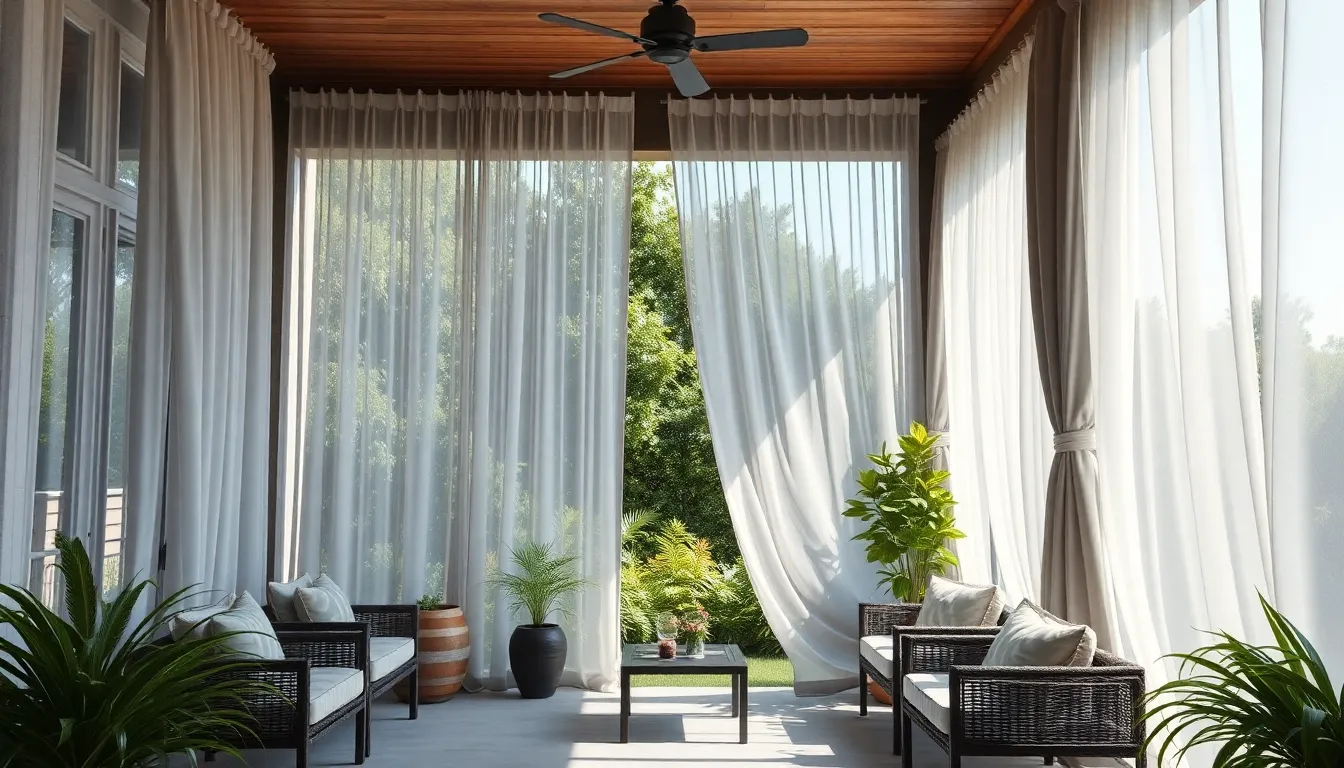
We can transform our patio into a private oasis with outdoor curtains and drapes that provide excellent sun protection while adding elegant style. These versatile answers block harmful UV rays, reduce heat by creating cooler zones, and shield us from light rain, wind, and insects while extending our outdoor living season.
Weather-Resistant Fabric Options
Polyester blends offer exceptional durability for outdoor curtains with their UV-resistant treatments that prevent fading over multiple seasons. Waterproof materials like vinyl-coated polyester provide complete rain protection while maintaining breathability for air circulation. Acrylic fabrics treated with mildew-resistant coatings ensure longevity in humid conditions and require minimal maintenance throughout the year.
Sheer fabrics create light filtering effects that maintain visibility while reducing glare and heat penetration. Blackout materials deliver maximum privacy and shade coverage for patios requiring complete sun blocking during peak hours. Solution-dyed acrylic fabrics resist color fading and maintain their appearance even after years of exposure to harsh weather conditions.
Treated canvas provides a natural aesthetic while offering substantial wind resistance and UV protection ratings up to 95%. Heavy-duty outdoor fabrics incorporate reinforced edges and grommets that withstand frequent opening and closing without tearing or stretching.
Track Systems and Installation Methods
Rod and ring systems create the simplest installation method for pergolas and gazebos with existing overhead beams or structures. Curtain rings slide smoothly along rods and allow easy adjustment for varying shade needs throughout the day. This setup works perfectly for patios where we need frequent access to open or close curtains based on weather conditions.
Track systems mounted to ceilings or walls provide seamless curtain movement with professional-grade hardware that handles heavy outdoor fabrics. Wall-mounted tracks accommodate curved or angled patio spaces while maintaining clean lines and architectural appeal. Ceiling installation offers maximum coverage area and works well for covered patios with solid roof structures.
Tie-backs and weighted hems control curtain movement during windy conditions while maintaining the flowing aesthetic we desire. Bottom weights sewn into curtain hems prevent excessive billowing while allowing gentle movement that enhances the outdoor ambiance. Strategic tie-back placement creates elegant draping effects while keeping walkways and seating areas accessible.
Color and Pattern Selection Tips
Light colored curtains in whites, creams, and soft pastels reflect heat while brightening shaded patio areas and creating an airy atmosphere. These lighter tones work exceptionally well with existing outdoor furniture and coordinate seamlessly with natural landscaping elements. Cream and beige options hide dirt and stains better than pure white while maintaining the bright, open feeling we want.
Darker hues provide superior UV blocking capabilities and maximum privacy protection but may absorb more heat during sunny days. Deep blues, forest greens, and charcoal grays offer sophisticated styling while delivering excellent sun protection for sensitive areas. Rich colors create dramatic contrast against light-colored patio surfaces and architectural features.
Pattern coordination with existing outdoor décor elements like cushions, rugs, and planters creates cohesive design schemes that enhance our patio’s visual appeal. Stripes add vertical or horizontal emphasis depending on our space requirements and aesthetic preferences. Geometric patterns introduce modern styling while floral designs complement garden settings and natural landscaping themes.
DIY Shade Structure Projects for Budget-Conscious Homeowners
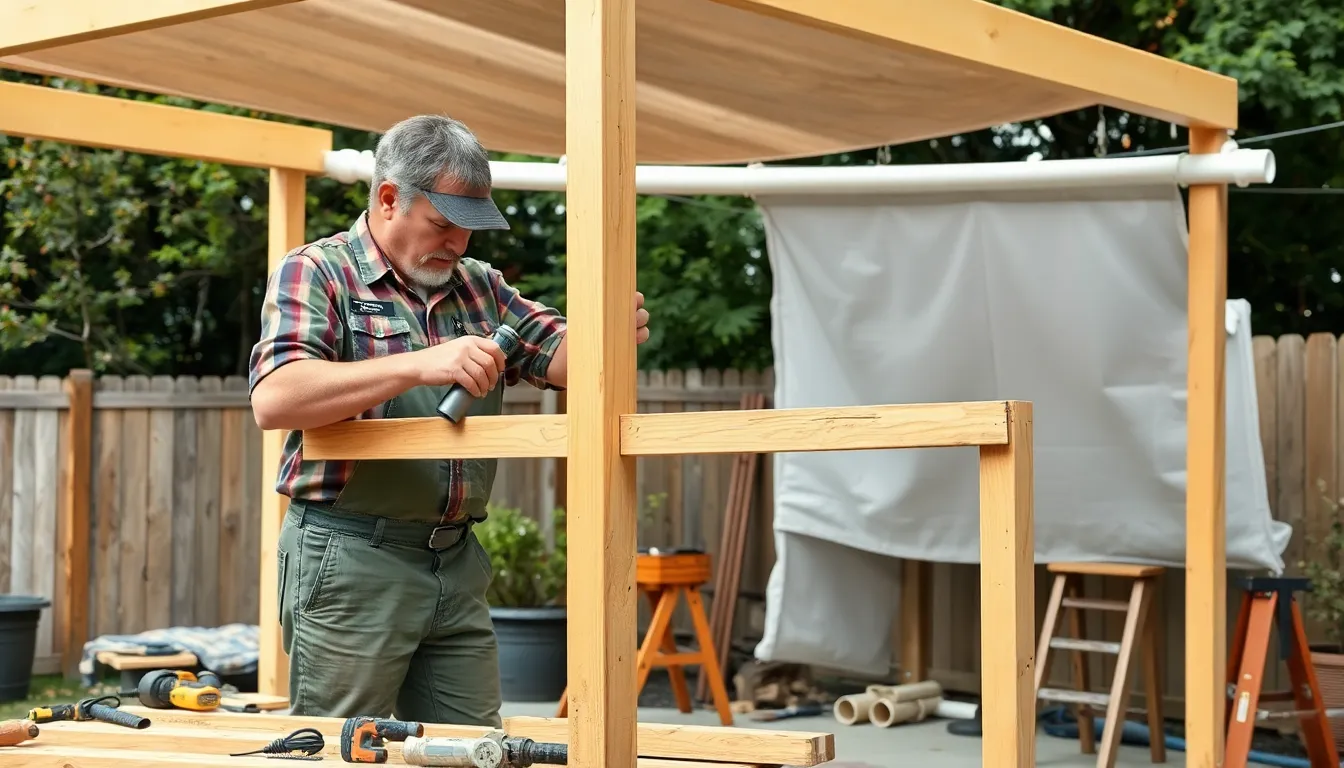
Creating effective patio shade doesn’t require a professional installation or expensive materials. We’ll explore budget-friendly projects that you can tackle yourself with basic tools and readily available supplies.
Drop Cloth and PVC Pipe Canopies
Canvas drop cloths paired with PVC pipes create one of the most affordable shade answers for patios. We recommend using treated drop cloths as they provide water resistance and durability for outdoor conditions. Building this canopy requires cutting PVC pipes to your desired frame dimensions and securing the fabric with zip ties or rope.
PVC cutters make clean cuts on the pipe framework while basic drilling tools create connection points for assembly. You’ll need moderate DIY skills to measure accurately and ensure proper fabric tension across the frame. This lightweight system can be customized to fit various patio shapes and sizes.
The total cost typically ranges from $30 to $80 depending on your canopy size. Canvas drop cloths offer excellent UV protection while remaining breathable for air circulation underneath.
Repurposed Materials and Creative Answers
Old wooden pallets transform into stylish pergola frames when combined with outdoor fabric or shade sails. We’ve seen homeowners create stunning overhead structures using reclaimed lumber from construction projects. Fabric scraps and leftover curtains work perfectly for adjustable shade panels that attach to existing structures.
Sun shade sails cost significantly less than permanent installations and can be layered for enhanced coverage. Multiple sails create ever-changing visual appeal while providing flexible shading throughout the day. Leftover construction materials like 2×4 lumber pieces build sturdy frames for fabric canopies.
Hanging fabric panels offer another creative approach using curtain rods or wire systems between posts. These answers require basic carpentry skills and common household tools you likely already own.
Tools and Skills Required for Installation
Most DIY shade projects need standard carpentry tools including saws, drills, screws, hammers, measuring tapes, and levels. Fabric handling requires scissors, grommet kits, and optionally a sewing machine for custom modifications. PVC pipe projects specifically need PVC cutters for clean, precise cuts.
Installation hardware includes zip ties, ropes, eye hooks, and wires for securing fabric elements. We recommend having these materials ready before starting your project to avoid delays.
| Skill Level | Project Type | Time Required |
|---|---|---|
| Beginner | Drop cloth canopies | 2-4 hours |
| Intermediate | Wooden frame structures | 4-8 hours |
| Beginner | Shade sail installation | 1-3 hours |
Measuring and cutting materials accurately ensures proper fit and professional appearance. Assembling frames requires attention to square corners and level installation. Installing anchors or suspension points demands understanding of your patio’s structural capabilities for safe, secure mounting.
Conclusion
Creating the perfect shade for your patio doesn’t have to be overwhelming or expensive. We’ve explored everything from high-tech retractable awnings and elegant pergolas to budget-friendly DIY answers and natural plant barriers.
The key is matching your shade solution to your exact needs—whether that’s flexibility with umbrellas and shade sails or permanent coverage with gazebos and living screens. Consider your budget your climate and how you’ll use the space when making your decision.
Remember that combining multiple shade strategies often works best. You might pair a pergola with climbing plants or add outdoor curtains to complement your existing umbrella setup.
Your patio can become the comfortable outdoor retreat you’ve always wanted. Start with one solution that fits your immediate needs and budget then build from there as your outdoor living space evolves.
Frequently Asked Questions
What are the best types of shade solutions for patios?
The most effective patio shade solutions include retractable awnings, pergolas, shade sails, market umbrellas, and gazebos. Each option offers different benefits: awnings provide flexible coverage, pergolas add architectural appeal, shade sails offer modern aesthetics, umbrellas give portable protection, and gazebos create enclosed outdoor rooms. Your choice depends on budget, patio size, and desired functionality.
How much do retractable awnings cost to install?
Retractable awning costs vary significantly based on size and features. Manual awnings typically range from $300-$2,500, while motorized versions cost $1,500-$5,000. Professional installation adds $500-$1,500 to the total cost. DIY installation can reduce expenses substantially, though proper mounting and tensioning require basic construction skills and appropriate tools.
What fabric is best for outdoor shade structures?
Solution-dyed acrylic fabric is the gold standard for outdoor shade, offering excellent UV protection (90-99%), fade resistance, and 8-12 year lifespan. Vinyl-coated polyester provides waterproof protection at a lower cost, while treated canvas offers natural aesthetics. Choose fabrics with high UV ratings and weather-resistant treatments for maximum durability and sun protection.
Can I install patio shade structures myself?
Many patio shade solutions are DIY-friendly, including shade sails, market umbrellas, and simple pergola kits. Basic projects like canvas canopies or PVC pipe structures require minimal skills and tools. However, complex installations involving electrical work, heavy structures, or permanent mounting may require professional installation for safety and optimal performance.
How do shade sails work and what sizes are available?
Shade sails are tensioned fabric panels that stretch between anchor points to create stylish overhead protection. They come in triangular, square, and custom shapes ranging from 8×8 feet to 20×20 feet or larger. Proper installation requires secure mounting points and adequate tension to prevent sagging while providing 85-98% UV protection.
What’s the difference between pergolas and gazebos?
Pergolas are open-roof structures that provide partial shade and architectural framework, often enhanced with retractable canopies or climbing plants. Gazebos are fully enclosed structures with solid roofs, creating complete outdoor rooms with weather protection. Pergolas cost less and offer more design flexibility, while gazebos provide superior weather protection and privacy.
How do I choose the right size patio umbrella?
Select umbrella size based on your seating area plus 2 feet on each side for adequate coverage. For small bistro tables, 6-7 foot umbrellas work well. Medium dining areas need 9-11 foot umbrellas, while large entertaining spaces require 13+ foot umbrellas. Cantilever designs provide more flexible placement and unobstructed space underneath.
What plants provide the best natural shade for patios?
Fast-growing trees like Crape Myrtle, Japanese Maple, and Honey Locust provide excellent overhead shade within 2-3 years. For vertical coverage, climbing plants like Boston Ivy, Clematis, and Grape Vines work well on trellises. Container plants offer flexibility for moveable shade, while living walls maximize coverage in small spaces.
Are outdoor curtains effective for patio shade?
Outdoor curtains provide excellent side protection from sun and wind while adding privacy and style. Weather-resistant fabrics like polyester blends and vinyl-coated materials offer UV protection and durability. Light colors reflect heat, while darker fabrics block more UV rays. Rod and track systems allow easy adjustment throughout the day.
What are some budget-friendly DIY shade options?
Cost-effective DIY shade includes canvas drop cloth canopies with PVC pipe frames ($50-150), repurposed pallet pergolas ($100-300), and simple shade sails with basic hardware ($75-200). These projects require minimal skills and tools while providing effective sun protection. Many materials can be sourced from home improvement stores or repurposed items.

